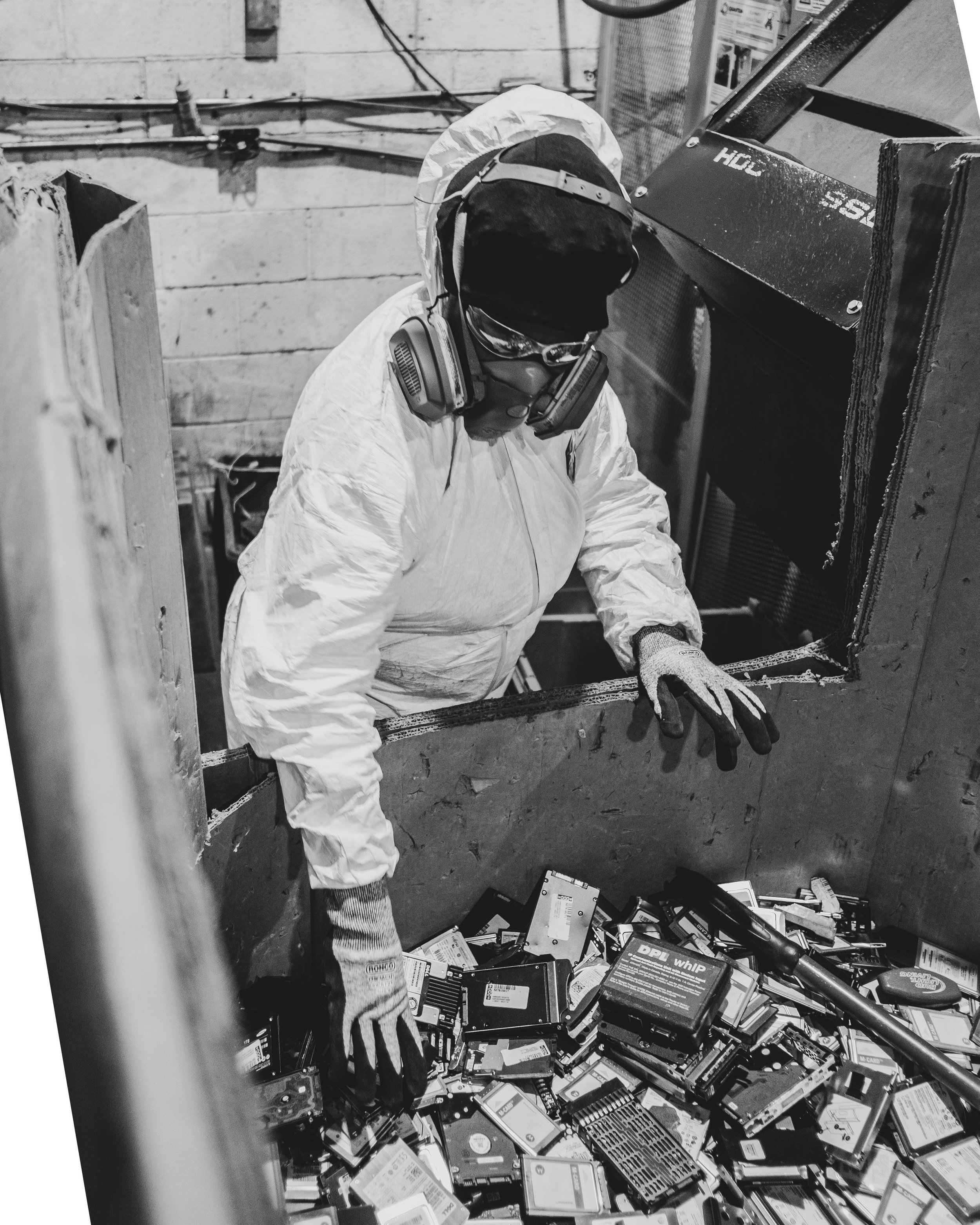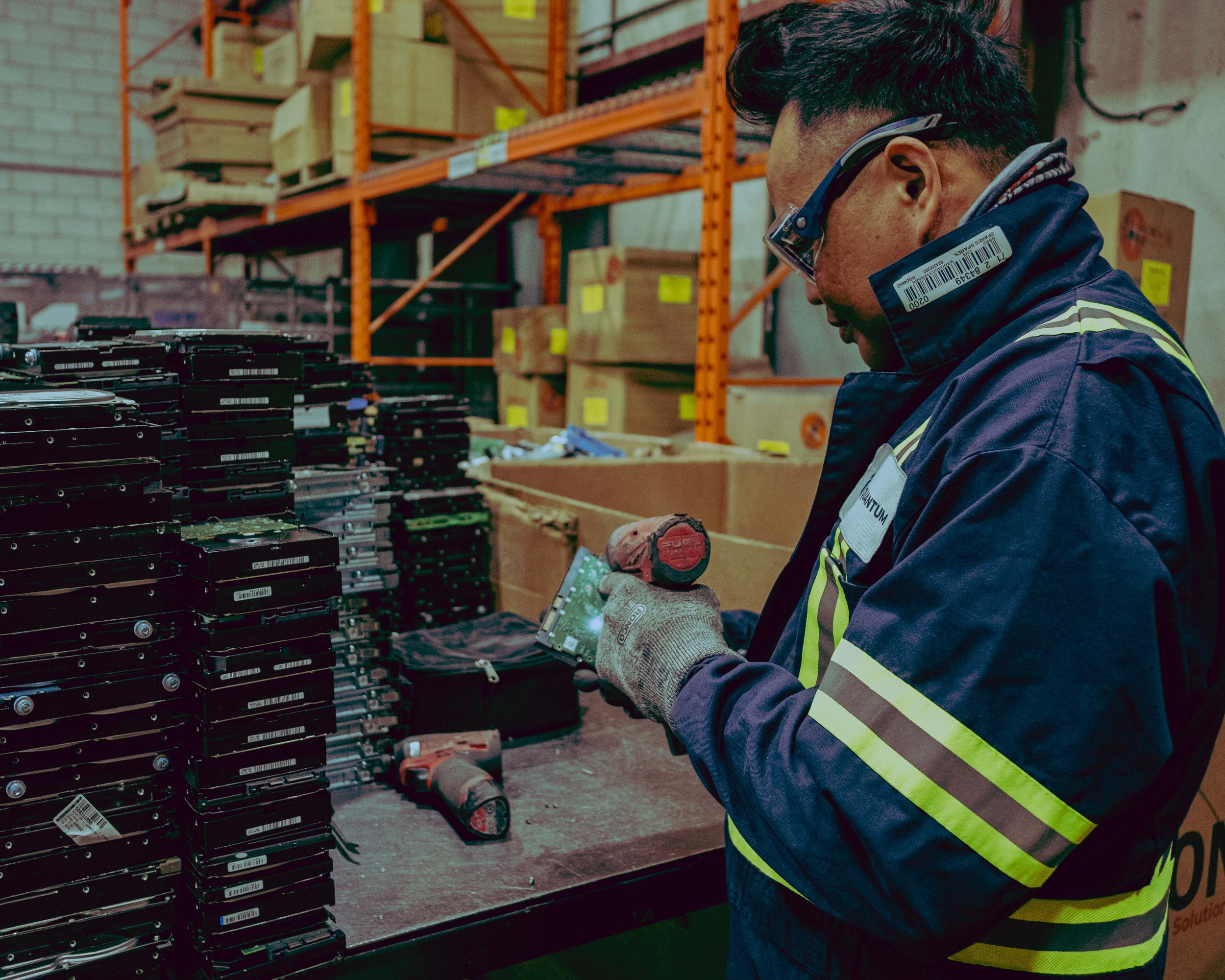Not long ago my friend Matt Hamilton who’s a Documentary videographer/drone pilot, and I were given the chance to capture the process of e-waste recycling at the Quantum Lifecycle Partners Facility in North York. Some weeks prior to this, we visited the facility to get a brief preview of what we were about to experience. During that initial visit, we were guided around by Clive, the Facility Manager. Clive proved to be an exceptional tour guide as he generously shared a wealth of information about their recycling procedures. The tour was truly captivating, providing us with a deep understanding of the intricate recycling process they employ. Throughout the excursion, both Matt and I constantly posed questions about every aspect that crossed our minds. Where did their e-waste supply originate? How was it collected? Why aren't e-waste bins a common sight in every building and condominium in Toronto? It became apparent that this topic was something worth exploring in more detail. I became naturally curious about the entire process along with the details of what happened to the materials after leaving the facility. During my off time, I delved into more comprehensive research. The article below is the details of everything I unearthed.
Recently we’ve seen a dramatic increase in the accumulation of electronic waste or e-waste. This increase is mainly due to rapid technological progress, practices of planned obsolescence, outdated Storage, and the affordability of electronic devices due to reduced costs. With the growing reliance on electronics globally, the problem of e-waste has grown significantly, making it the fastest-growing waste stream worldwide.
E-waste represents electronic devices that are no longer in service. Nonetheless, recognizing that not all e-waste components are completely useless is key. Unwanted devices that are still operable or repairable can be given away, reutilized, or restored, helping to alleviate the e-waste issue.
Grasping the Relevance of E-Waste Recycling
Before exploring the complexities of e-waste recycling, grasping why it is crucial is important. The principles of sustainable waste management serve to counter the harmful effects of waste, offering benefits, especially by maintaining the circulation of materials.
Governments globally, acknowledging the urgency of this, are advocating for increased awareness and pressing businesses in various sectors to accept greater accountability for their e-waste. This consequently provides consumers with options for recycling or repurposing their electronic goods. In a world where electronic waste management is struggling to stay abreast with consumption, the relevance of large-scale e-waste recycling cannot be emphasized enough. Without enhancements in management systems, we risk drowning in a deluge of broken electronics.
The Ramifications of Disregarding Electronic Waste (E-Waste) Recycling
Neglect in handling e-waste, which often involves incorrect disposal in landfills and burners, dispenses harmful chemicals into the earth, atmosphere, and water reserves. Various pollutants including lead, barium, phosphor, beryllium, cadmium, mercury, brominated dioxins, and polycyclic aromatic hydrocarbons can be diffused due to negligence. In time these toxic substances, notably heavy metals like mercury and cadmium, can cause severe damage to natural habitats, accumulate within food chains, and pose immediate health hazards to humans.
Moreover, the failure to recycle or reapply e-waste necessitates new extraction of natural resources for the production of electronic devices, rather than reusing the ones at hand. Valuable metals which are critical components of printed circuit boards – like gold, silver, platinum, and palladium, are becoming increasingly scarce. The ecological impact of sourcing these precious metals including the aspects of mining, transport, and production only to make "throwaway" devices, is substantial.
Benefits of E-Waste Recycling
On the other hand, e-waste recycling provides the potential for salvaging materials such as gold, copper, glass, aluminum, lithium, and plastic. A certain study I found while researching this topic estimated the worth of raw materials in e-waste to be roughly 55 billion euros in 2016. In Canada alone, that same year estimates show that only 20% of e-waste made it to proper Recycling facilities. Beyond the monetary worth, these materials seep back into the supply chain to produce new items, thus decreasing environmental damage, reducing hazardous waste, and enhancing the durability of electronics manufacturing.
(Source* https://drive.google.com/file/d/11DCXXZM-bflxHxk92gOXbweIceb40brP/view?pli=1)
Significantly, e-waste recycling has a substantial socio-economic footprint, contributing to nearly 681,000 employment opportunities in a single year, as stated by the Environmental Protection Agency (EPA). While e-waste recycling is just one aspect of this employment, its contribution is anticipated to grow as our dependency on digital appliances intensifies.
Hurdles in E-Waste Recycling
The United Nations predicts that, if present trends continue, electronic waste generated globally could see a shocking rise to 120 million tons each year by 2050. The challenges related to e-waste recycling and increasing diversion rates, however, are considerable.
Electronic waste commonly contains harmful chemicals and heavy metals, which not only make recycling tricky but also present dangers during the disposal process. Workers involved in the e-waste sector of developing countries are often exposed to unsafe conditions and potential toxic hazards. The unregulated recycling facilities in these places tend to use environmentally damaging practices, such as burning plastic to extricate metals.
Additionally, the wide range of electronic gadgetry, from Computers to mobile devices, and their complex makeup of different materials, makes recycling a complicated task. The segregation of these materials is a difficult, expensive, and time-bound process, especially when contrasted with single-material items.
Potential Solutions to E-Waste Recycling
Even though the barriers look intimidating, solutions to manage the electronic waste issue are already popping up. Different recyclable methods are currently available, and these commonly incorporate stages like collection, sorting, dismantling, shredding, mechanical separation, and recovery.
Looking at Mobile phones, a significant part of electronic waste, possess valuable constituents such as gold and silver. It's estimated that the improper disposal of phones by Canadians sums up to the loss of precious metals worth roughly $6 million every year.
Moving Towards a Circular Economy for E-Waste
The Basel Convention recognized e-waste as a problem back in 2002. However, the quest for a perfect zero e-waste world has only just begun in a real sense. As the digital era continues to grow, it's crucial that our approach toward a circular economy revolves around conscious consumption, reduction, and reuse of electronic materials.
Given that we're at the intersection of technological advancement and environmental responsibility, e-waste recycling is essential for the sustainability of our digital tomorrow. Companies like Quantum Lifecycle Partners are leading the way in recycling e-waste.
I aim to extend this project's scope to encompass the continuing phases of the e-waste recycling journey. This involves documenting the progression of the materials after leaving the facility, tracing their processing along the continuum until their eventual reintegration into circulation.
Please glance downward to view the images from this series.
























































